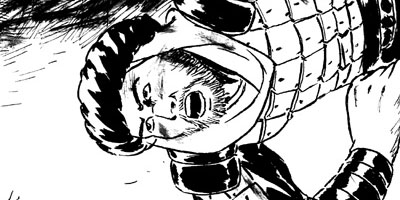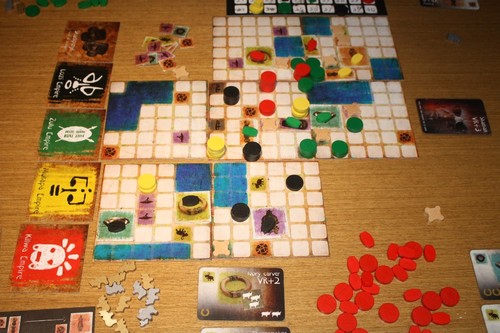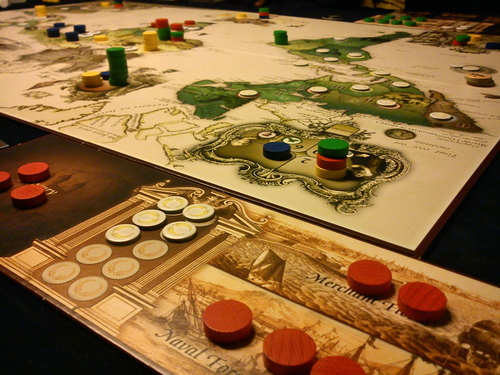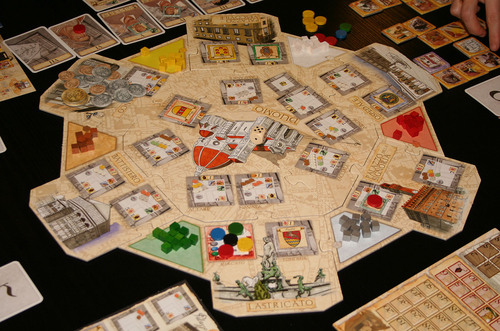And my Villain for Torontoist this year is the same as it is every year. There is a longstanding theory that people learn from experience, but Rob Ford seems dedicated to demonstrating that this theory does not have to be universal.
19
Dec
18
Dec
Hooray for social justice
Posted by MGK Published in Canadian Politics, I Really Should Have A Sociology Category, The InternetsTorontoist does its yearly Heroes and Villains at the end of every year, and my hero was the Toronto Marlies, for their equality pledge.
(My Villain is still forthcoming. Regulars can, uh, probably guess.)
18
Dec
Sex House was pretty brilliant, but The Onion’s new serial Youtube comedy is probably even darker than it was:
(Total runtime of all the episodes is about an hour and change.)
17
Dec
My weekly TV column is up at Torontoist.
17
Dec

Click on thumb to see full
As always, you can also go to the dedicated Al’Rashad site.
15
Dec
Liked it well enough (caveat: saw it in non-3D, non-48-frames-per-second-vision), but I have no idea how they think they get three movies out of this when the movie ends, unsurprisingly, about halfway through the damn book, and that is with all the extra stuff from the Indexes to LOTR thrown in and more besides.
15
Dec
Over at Torontoist, I participated in a roundtable discussion about the Toronto Raptors. And then, of course, the Raptors promptly won a game, presumably out of spite.
15
Dec
Quick question: Am I the only one who wants to see Star Trek Into Darkness that doesn’t care what villain Benedict Cumberbatch is playing? Because sometimes it feels like I am.
More and more it seems to me like the rebooted Trek franchise is being treated like a superhero movie series, where fandom thinks the goal of the fandom is to try to guess what pre-existing material will be adapted next, and the point is to recognize said material and go “Ooooooooooooooooooh I know what that is!” I am not above doing this (I enjoyed the Project: Pegasus sign in Avengers a bit more than I should have), but it’s not exactly the intended purpose of the movies, or the primary source of entertainment. Do people do this with other franchises? Do they eagerly anticipate news that Galvatron will be in the next Transformers, or that they’re bringing back Ernst Blofeld to fight Daniel Craig?
As soon as 2009’s Star Trek ended, people began speculating as to what the sequel would be about, and it’s only natural that this speculation is limited to bringing back X or revisiting Y. However, the difficulty in doing that with Star Trek is that the franchise has so few prominent recurring villains. Everybody immediately remembered Khan, and then promptly ran out of ideas.
Of course, Trek has many recurring villainous organizations–the Klingons, the Borg, the Maquis, Section 31, the Orion Synidcate, and so on. With continuity rebooted you can easily finagle it so that any of those groups are available to tangle with Kirk and Spock. But that doesn’t satisfy this primal fandom urge to see a singular archnemesis, looming just beyond the horizon and threatening to be ten times worse than the last villain. Fans want that moment where Batman’s finally gotten past the first movie and now he has to contend with a new fellow named…the Joker!!! But the Klingons, as an entire race, cannot be Star Trek’s Joker. Star Trek arguably does not have a Joker. 1
And so the fandom is left with the unenviable task of scouring the original Star Trek TV series to pick the best one-off anatognist that happens to line up with the plot and the casting of Cumberbatch. To date, Khan Singh (unfrozen 1990s ubermensch) and Gary Mitchell (Captain Kirk’s buddy corrupted by godlike power) are the leading candidates. Comic Book Resources put up an interesting list of suspects here, and I must admit that Ben Finney (Kirk’s buddy who went postal) and Garth of Izar (Kirk’s hero who went mad) are intriguing possibilities. But the fact I feel I must remind you who these characters are indicates that none of them are iconic enough to jusify all the hullaballoo about bringing them back. I find Garth particularly fascinating, but I can’t say he’d be substantially more fascinating than introducing a brand new character. 2
Therefore I see no point in trying to guess what the name of Cumberbatch’s character is. His identity doesn’t appear to be a plot point, and I have a rough idea of what the character’s motivations are, so his name is about as important to me as that of Eric Bana’s character in the last movie, which I frequently forget. If his name is “Gary Mitchell,” then I applaud the old school callback, but that doesn’t really tell me anything I’d like to know about the character. Frankly, I wouldn’t expect Cumberbatch’s Mitchell to be substantially different from Cumberbatch’s Khan–I’m pretty sure either way he’s going to be BBC’s Sherlock but evil and with more rayguns.
11
Dec
Contemplation on the responsibility of power, check. Massive earth-shattering action, check. Superman’s faith in the common man, check. About the only thing I’m not sold on is Lois Lane as a non-brunette, but other than that, yeah, I’ll be lining up like fuck for this one.
11
Dec
So occasionally I tweet something about a board game I have played recently and I got a few emails asking for more comprehensive run-downs, so why not.

The Great Zimbabwe is Splotter Spellen‘s latest game – it was introduced in September at the Essen games fair, and shipped shortly thereafter. (As an addendum to the Splotter post: they have, in the last year, become much more diligent about reprinting their popular games and you can now order most of their titles through their website. It is still quite pricey, to be sure, but you can get them.) I ordered it immediately because there is no Splotter title I have played that I have not loved immediately. The Great Zimbabwe does not break this streak.
At first glance, The Great Zimbabwe is your standard race-for-VPs game: you’re building temples to get VPs, very straightforward. But the trick is that everybody starts with a VP target of 20 – and then, as you start taking improvements to better yourself in the game (selecting a god who gives you a bonus, selecting a tribal specialist who gives you a different bonus, buying the craftsmen who let you improve the temples) your VP target to win the game increases, so now you are balancing advantages against your ability to win the game. On top of that, the game has a very clever economic engine, wherein most of the players’ expenses each turn for operating stores or purchasing specialist benefits are paid directly to other players – so maybe you take that mask carver early even though it’s going to increase your VP target, because now everybody will be buying masks from you, especially since early on you’re going to lay down mask carver shops near all the available wood and make it difficult for anyone else to get value from mask carving. Because you need that money to bid for turn order every turn and make sure you go first, so you get your pick of shops to improve your temples.
It’s all a very clever and wide-open economic game with an interesting area aspect to it – it’s not area control by any means, but it’s definitely area-influenced. Like most Splotters it gives you lots of options and strategies and generally leaves play options wide open. And like most Splotters, it is excellent. This was well worth the (stupid high) price.

Colonial debuted at Essen last year; there was a recent Kickstarter for a North American reprint, which then tied into the designer releasing “second edition” rules which – having played both versions now – are both much more well edited and balanced than the first edition was. The prominent issue from the first edition is still there – this is a game where “beat up the leader” is still very much a thing. However, it’s also not a game which falls into “takes forever” because of its beat-up-the-leader play; instead, it is a game that rewards cunning diplomatic skill, which is as it should be for a game which is fundamentally about European colonialism.
Gameplay features up to six identical “nations” playing a variety of cards each turn in player sequence. These cards each have two different abilities, which both limits player choice of action in an interesting way and which allows for a little improvisation during play (which is kind of neat, if you were planning to use the Explorer but then realize, hey, the Ambassador might be a better pick). You have a pool of wooden counters, which is your money when it’s in the bank and your colonists when they’re on the board and your ships when they’re in your fleets and your goods when you’re importing from the colonies, which is a very nice abstraction of bringing every aspect of colonialism down to raw economics.
Players can trade goods (their own or other players’ – the latter of which helps both players, which can be advisable at times), advance their science tracks to become better sailors or economic powers or what have you, take out loans for quick influxes of cash (which is both very useful and also limiting, because you can’t win the game while you have debt), explore the world to form colonies, emigrate your people to those colonies (or to other people’s, much in the way that Nieuw Amsterdam eventually became New York), inspire rebels to rise up against colonists, convert the natives to Christianity to prevent rebellions or, yes, go to war with other players. This last is particularly important because the method of winning the game is gaining ten prestige points, which are mostly gained by exploring or by establishing colonies, which would turn the game purely into a race – except that wars let you steal prestige points directly from other players. But there’s also a diplomacy track, and you have to play nice because you can’t declare war on somebody who’s further along the diplomacy track than you. (Or you can play dirty and then make up the difference by using ambassadors to bullshit your way back into acceptability.)
In case it’s not clear: Colonial absolutely oozes theme in a way that many Euros do not. There are all sorts of Eurogames about Europe colonizing the rest of the world and most of them are dry and boring affairs, but Colonial captures almost every aspect of the colonial race (yes, even slavery) and boils it down into mechanics that, while not quite simple, are elegant. There’s also a five-player “Nations” variant (that wasn’t balanced in first edition and, with the second, now works) that lets players take on special in-game powers to represent the Spanish, Portuguese, English, French and Dutch. I haven’t given it a go yet, but I am looking forward to it.

Florenza was… kind of disappointing. There are a lot of gamers out there who admire the gameplay of Caylus but wish it tied more closely to its theme, and so they create their own takes on Caylus’ pure, brilliant worker-placement engine but with more flavour, or at least more of what they consider flavour, and the result is always the same: a game that is not quite as good as Caylus is. (Lords of Waterdeep is an excellent example of this and one of the better attempts to turn Caylus into something more themey – but it’s just not as good a pure gaming experience as Caylus is, because the base game does not really offer the variant victory paths that Caylus does, so everybody just sort of does the same thing.)
Florenza is about merchant families building elaborate buildings in Renaissance-era Florence – I know what you’re thinking, “a Eurogame about merchants in Renaissance-era Italy? What are the odds?” Players build workshops that have powers on them that you can send workers to for things, just like in Caylus. You can build fancy monuments for VPs, just like in Caylus. And to make it more thematic, you compete for the skills of famous Renaissance-era artists and religious leaders, and since it’s set in Florence Assassin’s Creed players will recognize most of the names.
The problem is that Florenza gives players too many options in their worker placement. Worker placement, as a game mechanic, works when players are forced to compete for worker uses and have to decide where they want to place their worker on their turn because odds are the next time they get to place a worker, other players will have snapped up all of the other good stuff they’re considering. In Florenza, by midgame, each player has typically built 4-6 workshops, which means you can always get a lot of resources for your workers – and the area where you send workers to trade resources for other resources (so you can get the right combination of resources to build the Big Fancy Building That Gets You A Lot Of Points) is non-exclusive so you can just send a worker there any time. Which means that in the core of the game, there isn’t that much tension – and without that tension it just becomes an exercise in cubepushing.
11
Dec

Apologies for the lateness, but Technical Difficulties. You know how it is, right? Right.
As always, you can also go to the dedicated Al’Rashad site.
10
Dec
My weekly TV column is up at Torontoist.
10
Dec
Unfortunately, my internet at home is down because I made the mistake of thinking that maybe I should upgrade my internet to something that wouldn’t require me to pre-cache a lousy YouTube video and would actually make me consider subscribing to Netflix.
The punchline here is I live in Canada and expecting the internet people to make it easy for me to pay them more money for additional services was kind of a pipe dream, but they sure remembered to turn off my old internet. So, until they either turn on my old internet or set up the new one I am severely constrained in my posting capabilities.
9
Dec
Hey, this is the Tech Guy. We’ve got a new social network widget here. The old one wasn’t working reliably with Facebook, due to something on their end. To use the new widget, just mouse over or click on the placeholder graphic below the post – below the older sharing buttons. Compared to using the normal Like button, the pages will load faster and the Facebook tracking code won’t load automatically, which the privacy-conscious might appreciate.
I used a plugin for socialite.js, if you want to do something similar.
Please kick the tires and let me know if it works for you. Thanks!
8
Dec
ROM’s been in the news lately; Hasbro filed once again for the trademark on the property, prompting speculation that we may be in for a revival of the character. Personally, I don’t care so much about seeing future adventures as I do about getting reprints; if Marvel does get the rights back, the smart thing to do would be to pump out ‘Essential ROM’ Volumes 1 through However Many It Takes to Reprint His Every Appearance as fast as they can get the ink on the paper. Because ROM…ROM was freaking epic.
And I mean that literally. In a lot of ways, ROM foreshadowed episodic series whose individual stories built up into a single, large epic. Which is not to say that Bill Mantlo actually influenced people like J. Michael Straczynski or J.J. Abrams or Joss Whedon…but he was doing the same thing a long time before they did it. The 75-issue series starts with ROM’s arrival on Earth in pursuit of the Dire Wraiths, a species of evil shapeshifters that ROM and his fellow Spaceknights repelled from Galador and now hunt through the galaxy; and it doesn’t end until the epic conclusion of the Dire Wraith war (which crossed over into Marvel comics from ‘X-Men’ to ‘Fantastic Four’ to ‘Power Man and Iron Fist’) and ROM’s triumphant return to his home planet. There’s a lot of twists and turns in between, of course, but the whole series feels like it’s got a coherent beginning, middle and end. That’s very unusual in an era where you either had a twelve-issue miniseries, or you went for broke and tried to extend your run as long as you could. (To some extent, it’s a happy accident…I’m sure if ROM had sold better, he’d still be fighting the Dire Wraiths to this day.)
The character of ROM has a strong emotional arc through the series; he starts out consumed with guilt over allowing the Dire Wraiths to escape their Waterloo on Wraithworld, and slowly grows to regain his humanity (literally and figuratively) through his feelings for Brandy Clark. Brandy, meanwhile, has her own great arc; she goes from merely admiring ROM for his courage and nobility to becoming a hero in her own right, suffering loss and seeking vengeance. Bill Mantlo did a great job of making his characters accessible and sympathetic, especially when the series takes a turn for the horrific around issue #47. (I think this was actually the first issue of the series I read. The opening sequence, in which a member of the new, ruthless sorceress class of Wraith murders someone by drilling a hole in his forehead with her tongue and sucking out his brains like a Slurpee, is high on my list of Good Old Fashioned Nightmare Fuel.)
There’ve been appearances of ROM and the Spaceknights since the end of the series, which is good…but it’s that initial epic that I love, and that I want to see collected. Hopefully Hasbro and Marvel can make it happen, because with the rights to the Wraiths solidly held by Marvel, the rights to ROM don’t do anybody any good unless they can make an agreement.
Search
"[O]ne of the funniest bloggers on the planet... I only wish he updated more."
-- Popcrunch.com
"By MightyGodKing, we mean sexiest blog in western civilization."
-- Jenn
Contact
MGKontributors
The Big Board
MGKlassics

Blogroll
- ‘Aqoul
- 4th Letter
- Andrew Wheeler
- Balloon Juice
- Basic Instructions
- Blog@Newsarama
- Cat and Girl
- Chris Butcher
- Colby File
- Comics Should Be Good!
- Creekside
- Dave’s Long Box
- Dead Things On Sticks
- Digby
- Enjoy Every Sandwich
- Ezra Klein
- Fafblog
- Galloping Beaver
- Garth Turner
- House To Astonish
- Howling Curmudgeons
- James Berardinelli
- John Seavey
- Journalista
- Kash Mansori
- Ken Levine
- Kevin Church
- Kevin Drum
- Kung Fu Monkey
- Lawyers, Guns and Money
- Leonard Pierce
- Letterboxd – Christopher Bird - Letterboxd – Christopher Bird
- Little Dee
- Mark Kleiman
- Marmaduke Explained
- My Blahg
- Nobody Scores!
- Norman Wilner
- Nunc Scio
- Obsidian Wings
- Occasional Superheroine
- Pajiba!
- Paul Wells
- Penny Arcade
- Perry Bible Fellowship
- Plastikgyrl
- POGGE
- Progressive Ruin
- sayitwithpie
- scans_daily
- Scary-Go-Round
- Scott Tribe
- Tangible.ca
- The Big Picture
- The Bloggess
- The Comics Reporter
- The Cunning Realist
- The ISB
- The Non-Adventures of Wonderella
- The Savage Critics
- The Superest
- The X-Axis
- Torontoist.com
- Very Good Taste
- We The Robots
- XKCD
- Yirmumah!
Donate
Archives
- August 2023
- May 2022
- January 2022
- May 2021
- January 2021
- December 2020
- October 2020
- June 2020
- March 2020
- January 2020
- December 2019
- October 2019
- February 2019
- January 2019
- December 2018
- April 2018
- March 2018
- February 2018
- January 2018
- December 2017
- November 2017
- October 2017
- February 2017
- January 2017
- December 2016
- November 2016
- October 2016
- September 2016
- August 2016
- July 2016
- June 2016
- May 2016
- April 2016
- March 2016
- February 2016
- January 2016
- December 2015
- November 2015
- October 2015
- September 2015
- August 2015
- July 2015
- June 2015
- May 2015
- April 2015
- March 2015
- February 2015
- January 2015
- December 2014
- November 2014
- October 2014
- September 2014
- August 2014
- July 2014
- June 2014
- May 2014
- April 2014
- March 2014
- February 2014
- January 2014
- December 2013
- November 2013
- October 2013
- September 2013
- August 2013
- July 2013
- June 2013
- May 2013
- April 2013
- March 2013
- February 2013
- January 2013
- December 2012
- November 2012
- October 2012
- September 2012
- August 2012
- July 2012
- June 2012
- May 2012
- April 2012
- March 2012
- February 2012
- January 2012
- December 2011
- November 2011
- October 2011
- September 2011
- August 2011
- July 2011
- June 2011
- May 2011
- April 2011
- March 2011
- February 2011
- January 2011
- December 2010
- November 2010
- October 2010
- September 2010
- August 2010
- July 2010
- June 2010
- May 2010
- April 2010
- March 2010
- February 2010
- January 2010
- December 2009
- November 2009
- October 2009
- September 2009
- August 2009
- July 2009
- June 2009
- May 2009
- April 2009
- March 2009
- February 2009
- January 2009
- December 2008
- November 2008
- October 2008
- September 2008
- August 2008
- July 2008
- June 2008
- May 2008
- April 2008
- March 2008
- February 2008
- January 2008
- December 2007
- November 2007
- October 2007
- September 2007
- August 2007
- July 2007
- February 2007
Tweet Machine
- No Tweets Available
Recent Posts
- Server maintenance for https
- CALL FOR VOTES: the 2021 rec.sport.pro-wrestling Awards
- CALL FOR NOMINATIONS: The 2021 rec.sport.pro-wrestling Awards (the Theszies)
- The 2020 RSPW Awards – RESULTS
- CALL FOR VOTES: the 2020 Theszies (rec.sport.pro-wrestling Awards)
- CALL FOR NOMINATIONS: The 2020 Theszies (rec.sport.pro-wrestling awards)
- given today’s news
- If you can Schumacher it there you can Schumacher it anywhere
- The 2019 RSPW Awards – RESULTS
- CALL FOR VOTES – The 2019 RSPW Awards (The Theszies)
Recent Comments
- George Leonard in When Pogo Met Simple J. Malarkey
- Blob in How Jason Todd Went Wrong A Second Time
- Cindi Chesser in Thursday WHO'S WHO: The War Wheel
- Scott Hater in Bing, Bang, Bing, Fuck Off
- dan loz in Hey, remember how we talked a while a back about b…
- Sean in Server maintenance for https
- Ethan in CALL FOR VOTES: the 2021 rec.sport.pro-wrestling A…
- wyrmsine in ALIGNMENT CHART! Search Engines
- Jeff in CALL FOR VOTES: the 2021 rec.sport.pro-wrestling A…
- Greg in CALL FOR VOTES: the 2021 rec.sport.pro-wrestling A…
